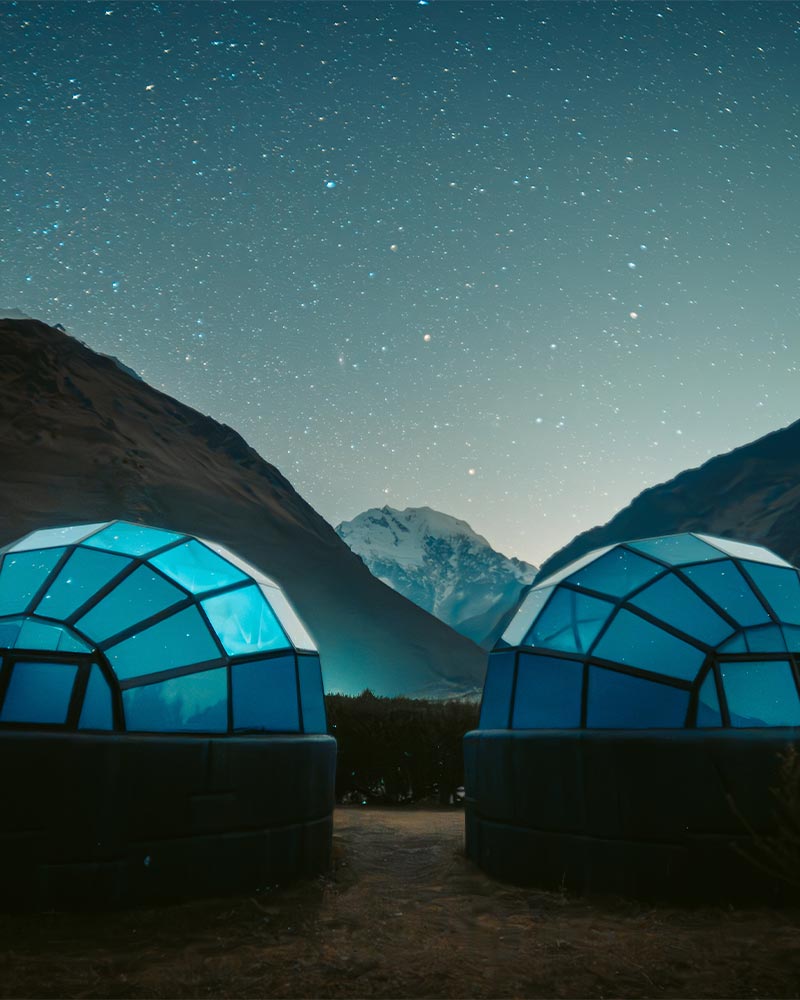What is the Best Time To Do the Salkantay Trek?
The best times of the year to enjoy the Salkantay Trek and experience the best weather are April and May or September and October. There are fewer tourists during these months, and the climate is pleasant, with minimal precipitation.
However, many travelers like to plan their excursions around other events in Cusco, and June is the prime month. During this time, the imperial city comes alive with jubilant festivities and the breathtaking celebration of Inti Raymi, an Inca festival that will leave you in awe.
Remember that Cusco can be more crowded during this period, so booking hotels, restaurants, and tours in advance is essential. Keep reading to discover a detailed description of the dry and rainy seasons throughout each month of the year on the Salkantay route. This way, you can optimally plan your Salkantay trek to Machu Picchu and make the most out of your experience.
Salkantay Trek in Rainy Season: What to Expect?
Throughout the Salkantay trek, the weather is unpredictable during the rainy season. However, being prepared is crucial! We recommend carrying a lightweight poncho or waterproof jacket in your backpack. Additionally, it's important to note that there will be days when it doesn't rain.
It's worth mentioning that January and February are the rainiest months on the route, and many hiking companies choose not to operate during this period. Moreover, the Inca Trail is also closed in February for maintenance due to the risk of slips and falls.
Below, you will find detailed information about what to expect during the rainy season in each month of the year.
Salkantay Trek in November
November marks the end of the dry season in Cusco and along the Salkantay Trek. The fields are dry and lacking color—but the rain is about to start and begin the wet season. The later on in the month you travel, the more likely you are to experience rain along the trek. However, the temperature overall is very pleasant, and you’ll feel warm most of the way.
Salkantay Trek in December
This month starts summer throughout the country and is when most national tourists vacation. Temperatures are still warm, but more rain will start to fall. This is a nice time of year to travel as you won’t see too many large crowds—just make sure you take waterproof gear in case.
Salkantay Trek in January
January is getting wetter, and you’ll see less of the sun this month. You’ll likely witness showers almost daily this time of year. They don’t tend to last long, though, and with help from the strong sun, the ground dries pretty quickly. You’ll still get to enjoy warm spells throughout the day.
Salkantay Trek in February
This is the wettest month along the Salkantay Trek, and it can cause the ground to get a little slippery. If you travel this month, take waterproof clothing and hiking boots with excellent grip. The weather is generally warm, though, and once the showers stop, you’ll enjoy being in the sun.
Salkantay Trek in March
The heavy rainfall continues throughout March, but you’ll also enjoy more breaks in the clouds and see the sun pop out more. The Salkantay trail is a little drier this month on the ground, so you’ll see more visitors on the trail again. Still, take all the right equipment to keep you dry and safe.
Salkantay Trek in April
Finally, the rain is ending, and there’s a significant drop in showers. April is still considered as part of the rainy season, but it’s far less wet. You’ll enjoy plenty of sun rays and generally pleasant days on the trail.
Salkantay Trek in Dry Season: What to Expect?
The dry season in Peru is known for its sunny days and the opportunity to indulge in the most breathtaking views of the Andean landscapes. However, this appealing weather also attracts numerous visitors who want to take advantage of the dry climate. Therefore, during these months, it is likely that you will encounter several people doing the Salkantay trek.
As mentioned earlier, planning is essential when traveling during the dry season, as the demand is high and everything gets booked in advance. We recommend making your reservations at least three months in advance to ensure you secure spots for the trek and hotels of your choice. Once inside Machu Picchu, you can climb Huayna Picchu mountain or Machu Picchu mountain if you have booked your tickets.
Below, we provide a breakdown of each month during the dry season on the Salkantay route, so you can plan your adventure optimally and make the most of your experience.
Salkantay Trek in May
Hooray! The dry season has officially begun. You might see showers here and there, but they’ll be short and light. Precipitation, in general, has decreased tenfold, and the climate is lovely during this time of the year. This is a great time to trek Salkantay before the large crowds come.
Salkantay Trek in June
This is the driest month of the year, and you’ll see little to no rainfall along the route. However, it’s also winter and the temperature at night drops dramatically. It can go below 0°C at the highest points of the route and the Soraypampa campsite. During the day, the climate is still nice and warm. If you travel in June, you must remember that in Cusco they’ll be celebrating their anniversary and it’s very busy throughout the city. You’ll likely see larger crowds on the route this month.
Salkantay Trek in July
July gets even colder at night, so you’ll need to make sure you have a very warm sleeping bag and lots of cozy clothes for your first night in Soraypampa. In the middle of the day, though, the high sun will keep you warm—use high SPF sunscreen for protection. There are patriotic festivities this month, so the city is still busy, as is the Salkantay Trek. Although July is in the middle of the dry season, you might experience an odd hailstorm.
Salkantay Trek in August
Winter is drawing to a close, but nighttime temperatures on the high-altitude parts of the Salkantay Trek will still be chilly. The days are getting warmer, and there’s still very little rainfall. August is still busy with tourists, and you can expect outstanding views along the route with clear skies.
Salkantay Trek in September
September is a wonderful time of year for weather. It’s getting warmer, and there’s only the odd shower now and again. You’ll feel warm and get to enjoy lots of sunshine and fantastic views. The tourists are still coming, but there aren’t quite so many. This is a great time of year to trip to Machu Picchu.
Salkantay Trek in October
This is the warmest month of the year on the Salkantay Trek, and we recommend traveling now to make the most of the climate while avoiding large crowds. The skies are mostly blue and clear, but you might experience light showers here and there. This is the last time of the year to get optimal views of Salkantay and Machu Picchu before it gets cloudier.
What Is the Average Temperature of Salkantay Trek?
Throughout the year, the temperature doesn’t fluctuate too much. The average temperatures at the Soraypampa campsite and in the higher altitude sections are around 20°C in the day (70°F) and then close to or below 0°C (32°F) at night.
As you head down to the jungle's edge, it gets much warmer, and you won’t be so cold at night. It’ll likely be around 26°C (80°F) on the day.
What Is the Coldest Month in Salkantay?
During the dry season in Cusco, winter makes its presence felt between June and July, with July slightly colder. These dates fall in the middle of the dry season, which means that nights are extremely cold, with temperatures dropping below freezing during the Salkantay trek.
To fully enjoy this winter experience, we recommend arriving well-prepared. It is essential to have a warm sleeping bag (-15°C) and multiple layers of warm clothing. This way, you will be protected from the intense cold at night. However, despite the low temperatures at night, the days remain fairly warm.
Does the Weather in Salkantay Affect Flights?
When planning your trip to Salkantay, it's important to note that flying directly to that destination is impossible as flights land in Cusco. However, it's important to consider the weather in Cusco, Peru, as it can affect flights. Nevertheless, this is usually a minor issue as airlines will provide alternative flights, or you may need to wait until the rain passes.
We advise you to stay informed about the weather conditions and any flight updates through the official channels of the airlines before your trip. Remember that while the weather may impact flights to Cusco, measures and solutions are in place to ensure that your journey to Salkantay is safe and satisfactory.
What to Pack When Visiting Salkantay?
Find an essential packing list for the Salkantay trek. Below, we have added a brief checklist of what you need to bring:
- Clothing - thin layers that you can take off and put on as the temperature changes.
- Raincoat or waterproof poncho.
- A warm jacket and sweater.
- Hand towel.
- Hiking boots or shoes - well worn-in.
- Sneakers.
- Warm pajamas.
- Sun hat, sunglasses, and sunscreen factor 50+.
- A warm hat, scarf, and gloves for the cold nights and when you’re up on a mountain on a trek.
- Insect repellent.
- Sandals.
- Toiletries.
- Reusable water bottle.
- Daypack to carry all your things around in.
- High-quality camera or phone with a good camera.
- Personal medication.
- Guide book/map.
- Passport.
- Lock for bags.
- Flashlight.
- Adaptors for plugs (if needed).
Plan Your Trip Now!
Our ultimate weather guide for the Salkantay trek provides a clear understanding of the best time to travel and which time of the year suits your preferences, whether it's avoiding crowds, enjoying breathtaking views, or avoiding the rain.
Most tourists hike the trail between May and October, with June being the busiest month. However, we recommend considering the rainy season if you prefer a more peaceful experience. Although the number of visitors decreases during this time, the weather remains pleasant.
If you decide to venture out during the rainy season, we guarantee an incredible experience. Just ensure you are prepared for possible drizzles by bringing the appropriate gear.
No matter which option you choose, it's time to get excited! An unparalleled hiking experience awaits you on the BEST ALTERNATIVE ROUTE TO MACHU PICCHU. Get ready for unforgettable moments!












